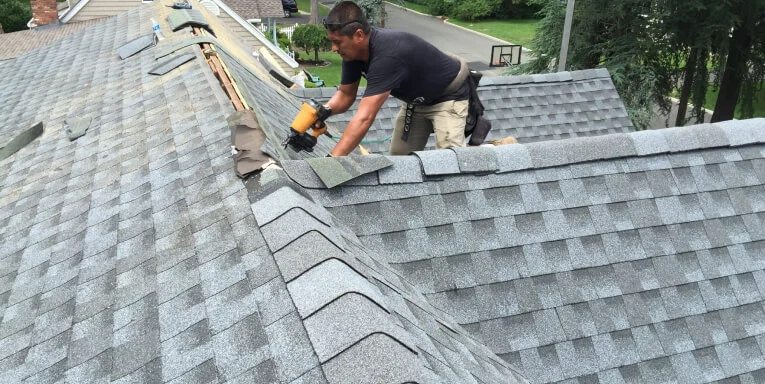When was the last time you had a roof inspection? Luckily, some roof issues are easy to spot from the ground, and many roof contractors offer free roof inspections to determine the roofing problems and solutions.
Ignoring common roof problems, no matter how small, can lead to severe damage, costly repairs, potential roof replacement, and safety issues.
Here is a list of the roof problems to know about so you can react in time and extend the life of your roof.
#1 Leaks and Moisture Damage
Leaking is one of the most common residential roof problems and a tricky one.
Bigger leakage is easy to spot through water stains on ceilings or walls, or dripping water inside your home. But, when you do not address small leaks on time, leakage causes mold and mildew development which further destroys your property and can cause health issues.
The most common culprits for leakage are:
- Damaged or missing shingles
- Flashing problems
- Clogged gutter
- Faulty roof system installation
Prevention and prompt reaction are the best course of action with roof leaks. Also, repairing damaged areas once you spot them prevents the problem from increasing and causing further roof damage.
In addition, professional roofers will fix the sealing around the vents, chimneys, and skylights.
#2 Shingle Damage
A common problem with roof shingles is granule loss, caused by weather and UV exposure. Granule loss is also a natural consequence of roof aging, and it shows that your roof is slowly losing its protective properties.
You can spot it by finding granules in gutters or by visually inspecting the roof for uneven appearance or missing shingles.
Other typical shingle issues include curling, cracking, and blistering, caused by weather or roof age.
With shingle common roofing problems, timely replacement of damaged parts is recommended. Also, schedule regular roof inspections and invest in quality materials to prevent roofing problems from recurring.
#3 Flashing Failures
Flashing is an essential roof part, which provides a watertight seal around different roofing components, chimneys, vents, and skylights. It prevents rainwater from entering your home and causing structural damage to walls and roof.
The most common roof issues with flashing are:
- Loose flashing construction caused by aging or storms
- Cracks and holes in the flashing
- Corrosion
Check for water leaks near chimneys and vents, look for signs of corrosion or rust, and identify gaps and cracks.
Contractors recommend regular roof repairs and inspection of flashing, and resealing. In addition,flashing roofing mistakes are often caused by poor installation. Therefore, pick your roofing contractors carefully to ensure quality service and adequate roof damage reconstructions.
#4 Poor Roof Ventilation
People often overlook the importance of ventilation or try to engage in DIY ventilation projects, leading to roof defects, which require professional handling.
Ventilation is an integral part of the roofing system, responsible for temperature and moisture regulation. Proper ventilation prevents ice dams and keeps the roof in good condition.
Most homeowners detect the following problems with ventilation:
- Blocked vents
- Insufficient ventilation, causing excessive heat and moisture build-up
- Improper or faulty vents, or entire ventilation systems
Problems with ventilation reflect higher energy bills, mold and mildew development, and ice dams in colder climates.
Ventilation is important for the roof structure and should be handled by professionals who may install additional vents, clean the vents, and install the ventilation system properly.
#5 Ponding Water
Ponding water is one of the 5 most common roofing problems, and issue number one on flat roofs. It happens when water accumulates on sections of the roofs with poor drainage. Debris buildup or sagging roof structure can also affect the slope and lead to water accumulation.
Inspect the roof for pools of water, discoloration, and deck sagging.
To address the ponding water, clear debris, reinforce sagging roof portions, and ensure good drainage. If the problem happens again and debris isn’t the culprit, consult professional roofers. They will evaluate the shape of your roof and suggest redesigning it to improve drainage.
#6 Gutter Problems
When you don’t maintain or replace gutters in time, you’ll experience water spilling over the sides, sagging gutter, and water pooling around the foundation. When not treated in time or after heavy storms and massive rainfalls, clogged gutters can contribute to water damage, foundation problems, and common roofing issues, such as leaks and mold.
Most homeowners report that leaves, debris, and ice dams often accumulate in their gutters. Likewise, improper gutter installation can lead to other problems with your roof.
Solutions for gutter issues include regular cleaning, timely gutter replacement, and gutter guard installation with an adequate pitch to maximize water flow.
#7 Roof Punctures and Penetrations
Next on our list of roof issues, and a relatively common metal roof problem are punctures and holes. The causes are:
- Fallen branches and flying debris during storms
- Foot traffic (on a flat roof, during roof repairs or installation)
- Animals
- Poorly installed HVAC units and satellite dishes
If you suspect your roof has holes, take binoculars or go on the roof and look for holes and tears. Inside, check for water stains or dripping water during rain.
Often, addressing holes in the roof requires professional handling to treat the underlying materials and seal the roof.
#8 Tree Damage
Trees provide shade and UV protection, but they can also be the reason behind several roofing issues. If you don’t prune the trees, the overhanging branches may scrap shingles, and leaves can clog gutters. The consequences may include leaf buildup responsible for ponding water, etc.
During storms, branches can break and damage the shingles even more.
In addition, removing dead and damaged trees near your home is recommended to reduce the mentioned risks.
Conduct regular roof checks and remove dead branches and leaves to minimize tree damage.
#9 Roof Aging
All roof types have a limited lifespan because materials naturally degrade over time. In addition, exposure to weather conditions further accelerates the degradation process, so the roof requires more frequent repairs and shows visible signs of aging. Those include widespread shingle damage, frequent and extensive leaks, sagging roofline, fading, etc.
The only solution for roof aging is timely roof replacement. For example, for asphalt shingles, roof replacement is recommended every 20 to 30 years. Metal roofs require replacement after half a century, while slate roofs can last almost a century.
#10 Moss and Algae Growth
Moss and algae growth is one of the common problems on roofs in hot and humid climates with plenty of rainfalls, like in Florida. Shaded areas of the roof can retain moisture and become a spot for mold, algae, and moss.
Check your roof for black or green streaks, and moss patches to determine the scope of the problem.
Not only are these problems aesthetic issues, but they can further damage the roof and weaken the roof structure.
Here is how you can address the issue:
- Regular roof cleaning
- Zinc or copper strips
- Regular tree pruning to prevent shady areas from growing algae
Preventive Maintenance Tips
Because of homeowners’ low awareness about ongoing roof maintenance, minor roof issues go unnoticed until they cause big damage.
Therefore, the key to keeping the roof operative for years and preventing costly repairs are roof inspection and timely reactions. In addition, if you live in an area prone to destructive storms, inspections for roof damage are needed after severe weather. That way, you’ll catch issues early.
Next, keeping the roof clean of debris prevents moss, algae, clogged gutters, damaged shingles, etc. You can manually clean the roof or use a pressure washer.
Ask around for your local contractors about regular inspections, repairs, and routine maintenance to extend the durability of the roof.
Conclusion
As one of the most important property parts, the roof is prone to various problems caused by aging, weather, and improper maintenance. Leakage, moss, mold, gutter issues, flashing problems, and shingles deterioration bother most people and can be easy to spot.
However, minor leakage issues, smaller holes, and debris buildup on roof areas that aren’t visible from the ground can often go undetected. To prevent that scenario, schedule a regular roof inspection to be aware of the roof condition and fix repairs before the next storm.
FAQ
When should I call the roof contractor for an inspection?
Several roof issues are signs that it is time to schedule a roof inspection: leaks, missing shingles, water stains, loud noise coming from the roof during storms, sagging roof deck, roof age, etc.
How do I know I need to replace my roof instead of repairing it?
Widespread damage and structural issues cannot be repaired. In those cases, replacement is a better solution. Similarly, if your roof has come close to the end of its expected lifespan, or there is an extensive leakage with costly roofing problems, replacement may offer more advantages.
How can I fix water stains on my ceiling?
The first step is to detect the leak and contain it. Inspect the roof, gutters, and flashing. If possible, try to patch it temporarily and call a professional roofer to repair the leak.






